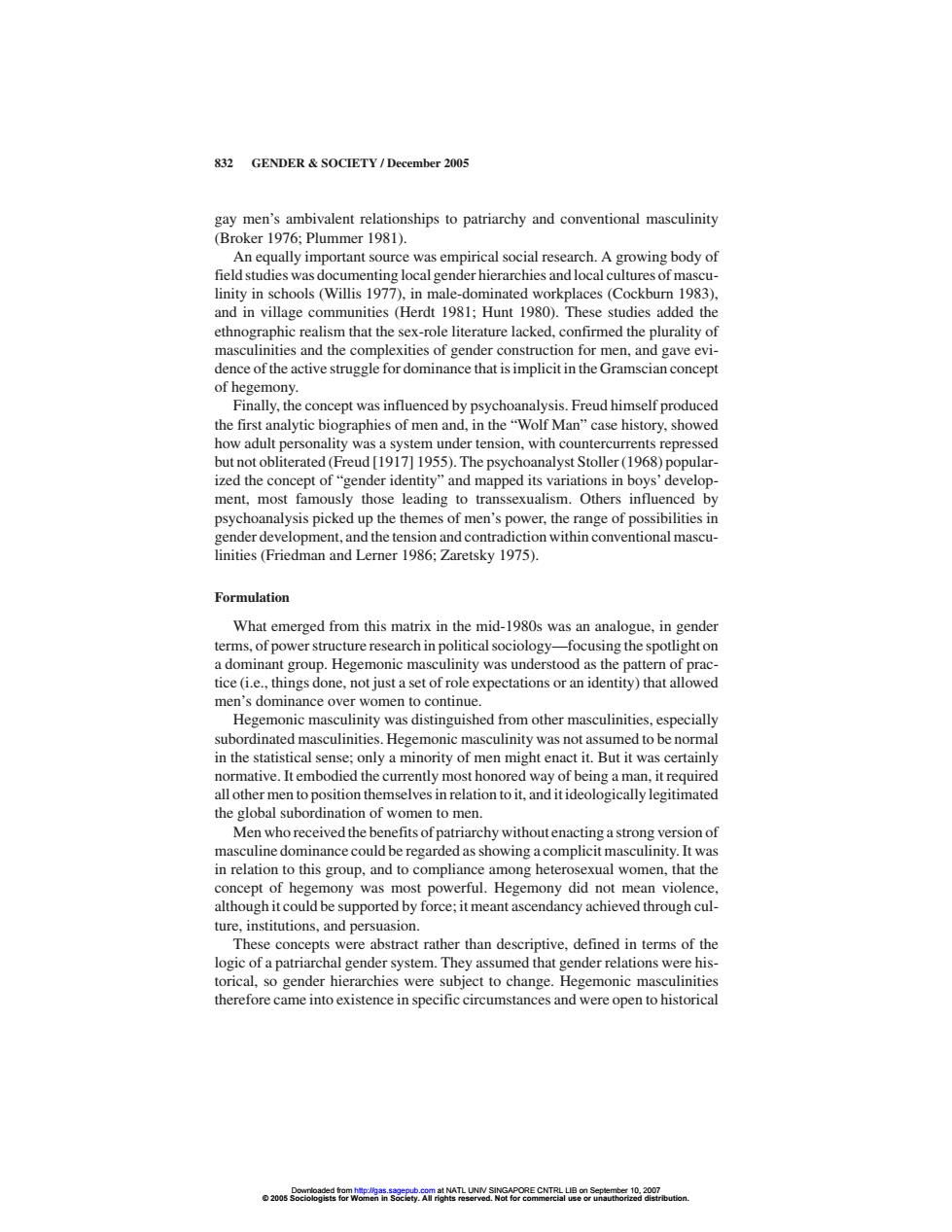正在加载图片...

832 GENDER SOCIETY/December 2005 gay men's ambivalent relationships to patriarchy and conventional masculinity (Broker 1976:Plummer 1981). An equally important source was empirical social research.A growing body of field studies was documenting local gender hierarchies and local cultures of mascu- linity in schools (Willis 1977),in male-dominated workplaces (Cockburn 1983), and in village communities (Herdt 1981;Hunt 1980).These studies added the ethnographic realism that the sex-role literature lacked,confirmed the plurality of masculinities and the complexities of gender construction for men,and gave evi- dence of the active struggle for dominance that is implicit in the Gramscian concept of hegemony. Finally,the concept was influenced by psychoanalysis.Freud himself produced the first analytic biographies of men and,in the"Wolf Man"case history,showed how adult personality was a system under tension,with countercurrents repressed but not obliterated (Freud [1917]1955).The psychoanalyst Stoller(1968)popular- ized the concept of"gender identity"and mapped its variations in boys'develop- ment,most famously those leading to transsexualism.Others influenced by psychoanalysis picked up the themes of men's power,the range of possibilities in gender development,and the tension and contradiction within conventional mascu- linities (Friedman and Lerner 1986:Zaretsky 1975). Formulation What emerged from this matrix in the mid-1980s was an analogue,in gender terms,of power structure research in political sociology-focusing the spotlight on a dominant group.Hegemonic masculinity was understood as the pattern of prac- tice (i.e.,things done,not just a set of role expectations or an identity)that allowed men's dominance over women to continue Hegemonic masculinity was distinguished from other masculinities,especially subordinated masculinities.Hegemonic masculinity was not assumed to be normal in the statistical sense;only a minority of men might enact it.But it was certainly normative.It embodied the currently most honored way of being a man,it required all other men to position themselves in relation to it,and it ideologically legitimated the global subordination of women to men Men who received the benefits of patriarchy without enacting a strong version of masculine dominance could be regarded as showing a complicit masculinity.It was in relation to this group,and to compliance among heterosexual women,that the concept of hegemony was most powerful.Hegemony did not mean violence, although it could be supported by force;it meant ascendancy achieved through cul- ture,institutions,and persuasion These concepts were abstract rather than descriptive,defined in terms of the logic of a patriarchal gender system.They assumed that gender relations were his- torical,so gender hierarchies were subject to change.Hegemonic masculinities therefore came into existence in specific circumstances and were open to historical o2oosS6e08a8rmh8Pg532RT4T6066O2ECTBgarto1827butiongay men’s ambivalent relationships to patriarchy and conventional masculinity (Broker 1976; Plummer 1981). An equally important source was empirical social research. A growing body of field studies was documenting local gender hierarchies and local cultures of masculinity in schools (Willis 1977), in male-dominated workplaces (Cockburn 1983), and in village communities (Herdt 1981; Hunt 1980). These studies added the ethnographic realism that the sex-role literature lacked, confirmed the plurality of masculinities and the complexities of gender construction for men, and gave evidence of the active struggle for dominance that is implicit in the Gramscian concept of hegemony. Finally, the concept was influenced by psychoanalysis. Freud himself produced the first analytic biographies of men and, in the “Wolf Man” case history, showed how adult personality was a system under tension, with countercurrents repressed but not obliterated (Freud [1917] 1955). The psychoanalyst Stoller (1968) popularized the concept of “gender identity” and mapped its variations in boys’ development, most famously those leading to transsexualism. Others influenced by psychoanalysis picked up the themes of men’s power, the range of possibilities in gender development, and the tension and contradiction within conventional masculinities (Friedman and Lerner 1986; Zaretsky 1975). Formulation What emerged from this matrix in the mid-1980s was an analogue, in gender terms, of power structure research in political sociology—focusing the spotlight on a dominant group. Hegemonic masculinity was understood as the pattern of practice (i.e., things done, not just a set of role expectations or an identity) that allowed men’s dominance over women to continue. Hegemonic masculinity was distinguished from other masculinities, especially subordinated masculinities. Hegemonic masculinity was not assumed to be normal in the statistical sense; only a minority of men might enact it. But it was certainly normative. It embodied the currently most honored way of being a man, it required all other men to position themselves in relation to it, and it ideologically legitimated the global subordination of women to men. Men who received the benefits of patriarchy without enacting a strong version of masculine dominance could be regarded as showing a complicit masculinity. It was in relation to this group, and to compliance among heterosexual women, that the concept of hegemony was most powerful. Hegemony did not mean violence, although it could be supported by force; it meant ascendancy achieved through culture, institutions, and persuasion. These concepts were abstract rather than descriptive, defined in terms of the logic of a patriarchal gender system. They assumed that gender relations were historical, so gender hierarchies were subject to change. Hegemonic masculinities therefore came into existence in specific circumstances and were open to historical 832 GENDER & SOCIETY / December 2005 © 2005 Sociologists for Women in Society. All rights reserved. Not for commercial use or unauthorized distribution. Downloaded from http://gas.sagepub.com at NATL UNIV SINGAPORE CNTRL LIB on September 10, 2007